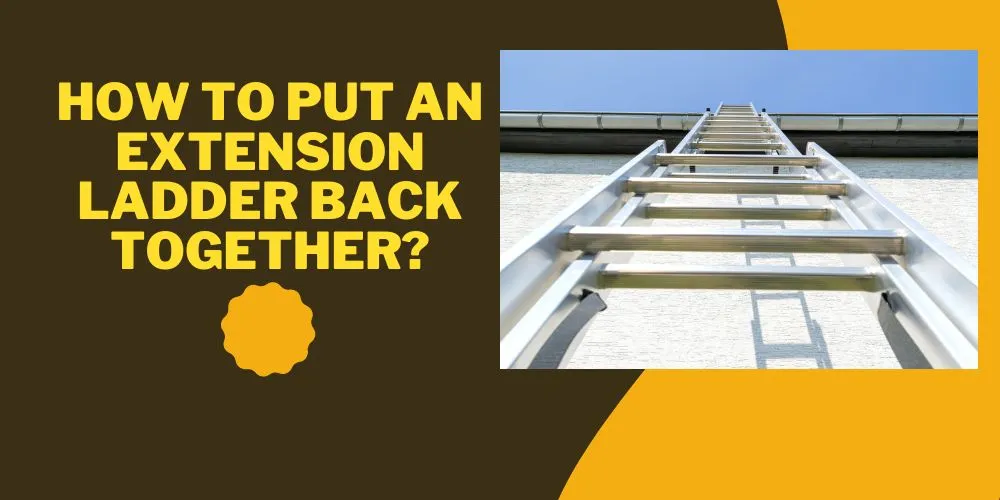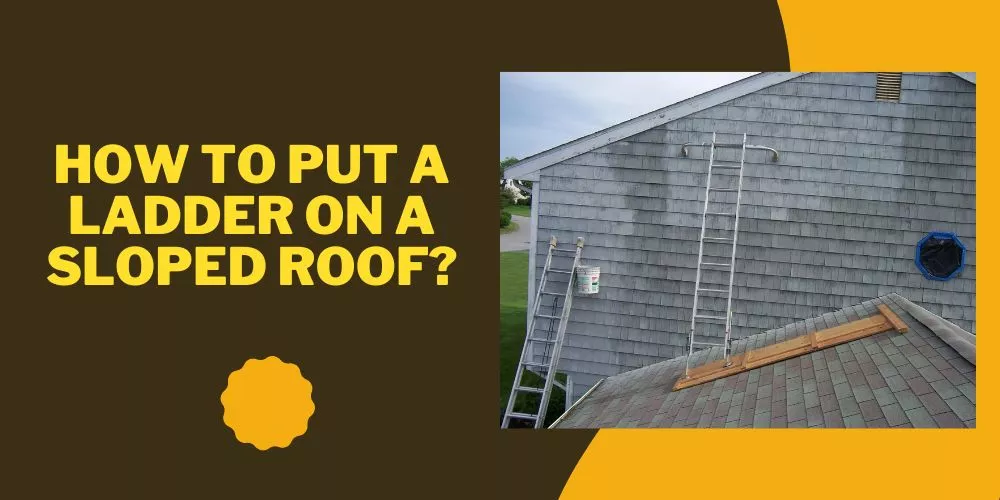We’ve all been there – needing to change a burnt-out lightbulb, reach a high shelf, or complete a DIY home improvement project. Often, these tasks require the use of a ladder.
However, if your walls are made of drywall, leaning a ladder against them can seem quite intimidating – no one wants to damage their walls and end up with unnecessary repair work.
Therefore, learning how to lean ladder against drywall safely and correctly is crucial to both maintain the integrity of your home structure and ensure personal safety.
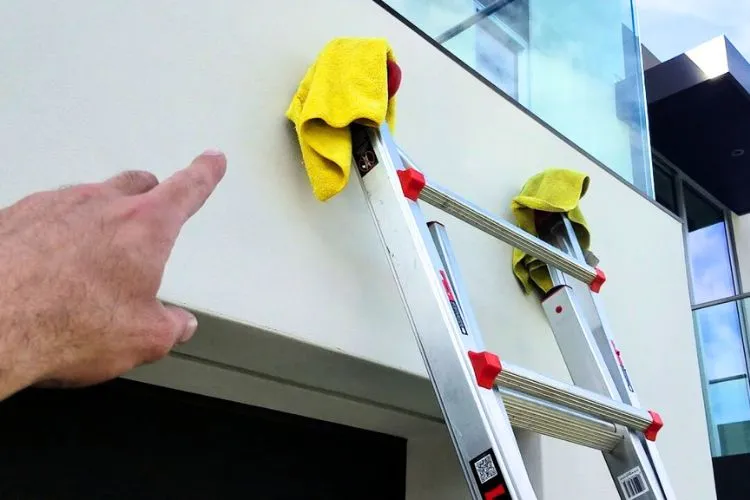
This article will provide a comprehensive guide on how to do this, offering practical advice and step-by-step instructions to give you the confidence to get that job done – and keep your drywall intact.
How To Lean Ladder Against Drywall? A Stepwise Guide
Before you go ahead to lean your ladder against your drywall, it’s important to understand that drywall alone isn’t strong enough to support the weight of a ladder and a person combined.
With that in mind, it’s essential to take precautions to avoid causing any damage to your drywall.
Here’s a step-by-step guide on how to safely lean a ladder against drywall:
🪜 Gather Necessary Materials
You’ll need a few items to protect your wall and increase the safety of your setup:
- A sturdy ladder
- A ladder stabilizer or mitts
- Stud finder tool
- A helping hand if available
🪜 Identify a Support Structure
Using your stud finder, locate the studs behind the drywall. The ladder needs to lean against these wood beams for support, rather than against the drywall itself. If a stud is not available, look for a strong door frame, which can also work as a good support.
🪜 Install Ladder Stabilizer or Mitts
To protect your drywall and bring additional safety, it’s advisable to attach a ladder stabilizer or mitts to your ladder. These accessories disperse the weight and pressure from the ladder over a larger area, minimizing the risk of damage.
🪜 Position Ladder Correctly
The ladder should be placed in the correct angle to ensure balance and stability. A good rule of thumb is the 4-to-1 rule. For every four feet of height you have to climb, move the base one foot away from the wall.
Example: If the top of the ladder is 16 feet high, then the base should be 4 feet away from the wall.
🪜 Secure the Ladder
Before you climb, make sure the ladder is secure. If at all possible, have someone hold the base while you’re climbing.
🪜 Test the Setup
Climb only one or two steps, and gently move around to check the ladder’s stability. If it feels unsteady, get down, and adjust it until you feel properly balanced.
Remember that climbing higher on the ladder will put more pressure on the wall, so after adjusting, you should test it once more to be sure that your setup is stable.
🪜 Climb Safely
Finally, when climbing, make sure you always maintain three points of contact (two hands and a foot or two feet and a hand) with the ladder.
This guide will help you use a ladder against drywall safely, preventing accidents and avoiding damage to your walls. However, be sure to follow the manufacturer’s instructions when using any ladder or accessory.
Locating a Stud and Why It’s Important: A Detailed Explanation
Your drywall is made of sheets of gypsum, a lightweight and relatively soft mineral, which are then covered in a heavy paper surface. As such, while they make excellent and cost-effective walls and ceilings, they’re not designed to bear heavy loads. Therefore, leaning your ladder against drywall might damage it.
This is why you need to lean your ladder on the stud behind the drywall. A stud is one of a series of slender, vertical wooden structures that frame the walls of a building. They provide the necessary support for your drywall and, significantly, can bear heavy loads.
🪜 How to locate a Stud?
Locating a stud is not difficult, but it requires a proper tool — a stud finder. Here’s how to do it:
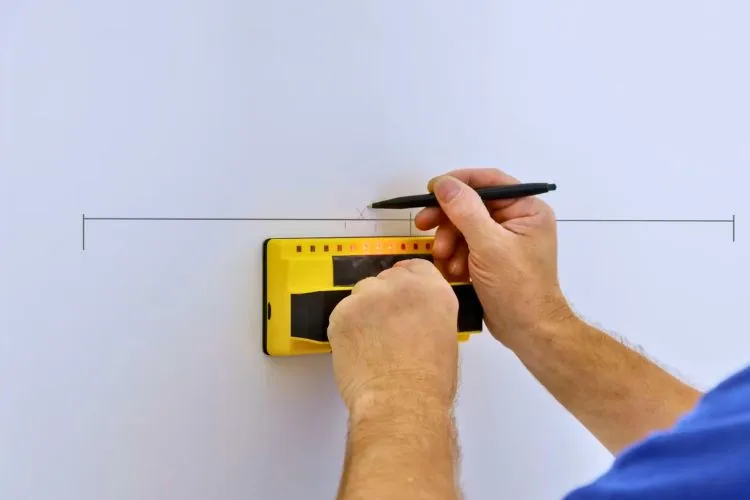
- Step 1: Start by powering on your electronic stud finder and placing it flat on the wall. The flat surface that should go against the wall is typically well-indicated.
- Step 2: While holding down the activation button, start sliding the stud finder horizontally across the wall.
- Step 3: Once the tool signals the presence of a stud – often in the form of a beeping sound or a light indicator – mark the wall with a pencil.
- Step 4: Continue moving the stud finder past the point where it first signaled a stud. It will signal again when you’ve reached the end of the stud. Mark this second point too.
The area between those two points is generally where the center of your stud should be. Always double-check by using the stud finder again to locate the center.
🪜 Stud Finder Types
There are two principal types of stud finders:
- Magnetic Stud Finders: These devices use magnetism to locate metal nails in the wooden stud, and they don’t require batteries. Their main drawback is that they may not be as accurate as their electronic counterparts.
- Electronic Stud Finders: These devices detect changes in the wall thickness. They’re generally more reliable and easier to use than magnetic stud finders.
In conclusion, taking the time to locate the studs behind the drywall can save potential damage to your walls and ensure your safety while working at height. An accurately positioned ladder will provide you with steady and reliable support, serving as the foundation to complete your work safely and effectively.
Preventive Measures for Protecting Drywall: A Comprehensive Guide
When using a ladder in your home, protecting your drywall should be a top priority, as excessive pressure from the ladder can cause dents, cracks, or holes in the wall. To avoid these potential damages, here are several preventive measures that will help you safeguard your drywall:
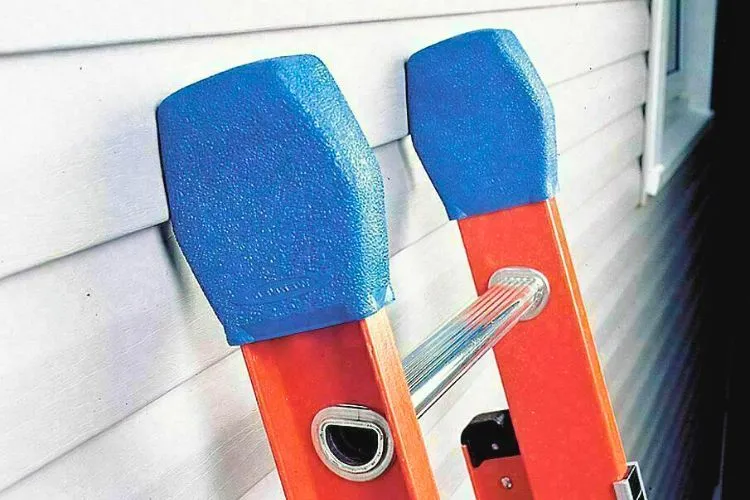
🪜 Locate and Use Studs
Always make it a priority to lean the ladder against the studs behind the drywall, as these wooden structures can bear the ladder’s weight without causing damage.
🪜 Use Padded Mitts or Ladder Covers
Ladder mitts or covers are padded accessories that fit over the top ends of the ladder rails. These cushions can help to distribute the weight of the ladder over a larger area, reducing pressure on the drywall.
Step-by-Step Guide for Using Padded Mitts:
- Purchase a pair of ladder mitts or ladder covers suitable for your ladder type.
- Slide the mitts onto the top ends of the ladder rails.
- Position the ladder with the mitts facing the drywall. The padded surface will protect the wall from damage.
🪜 Utilize a Ladder Stabilizer
A ladder stabilizer is an accessory that attaches to the top of the ladder, providing additional support and preventing direct contact between the ladder and wall.
Step-by-Step Guide for Installing a Ladder Stabilizer:
- Purchase a ladder stabilizer compatible with your ladder.
- Follow the manufacturer’s instructions to correctly attach the stabilizer to the ladder.
- Ensure that the ladder is positioned correctly, with the stabilizer touching the wall surface instead of the ladder rails.
🪜 Use Plywood or Foam Board as a Barrier
If you don’t have any ladder accessories, you can use a piece of plywood or foam board cut to a suitable size to protect the drywall.
Step-by-Step Guide for Using Plywood or Foam Board:
- Measure and cut a piece of plywood or foam board large enough to cover the area where the ladder will lean against the wall — the height should be slightly more than the ladder’s rails width.
- Place the plywood or foam board against the wall where you plan to lean the ladder.
- Position the ladder against the plywood or foam board, which will help distribute the weight and protect the drywall.
🪜 Get Assistance from a Partner
It’s always beneficial to have a partner hold the ladder’s base, especially when you lack ladder accessories, or when working in challenging spots. This extra support minimizes wall damage and increases safety.
By following these preventive measures, you can keep your drywall safe from potential damage while using a ladder for various tasks around your home. These simple strategies will ensure both your property and safety are intact in the process.
Conclusion:
Using a ladder against drywall requires careful consideration to protect the wall and maintain safety. Always aim to distribute weight by using protective ladder accessories or barriers such as plywood, and above all, aspire to lean on the studs behind the drywall.
With careful positioning, adherence to the 4-to-1 rule for ladder placement, and using safety measures such as stabilizers, mitts, or an assistant, you can ensure your task is handled effectively and safely, preventing any damage to your drywall.
Following these tips will enable a smooth, safe, and successful ladder use experience.

